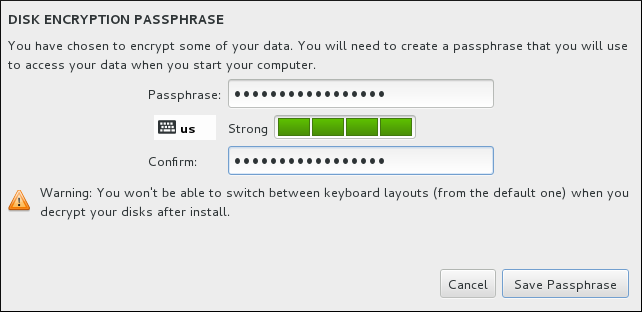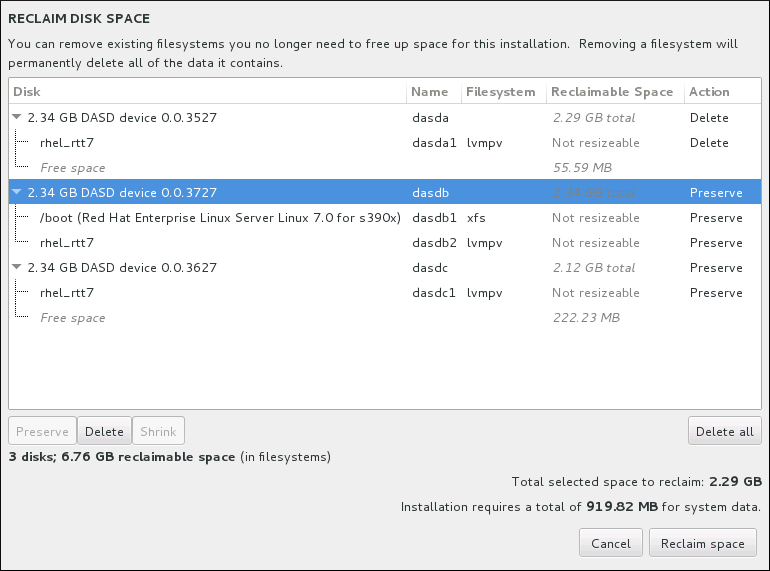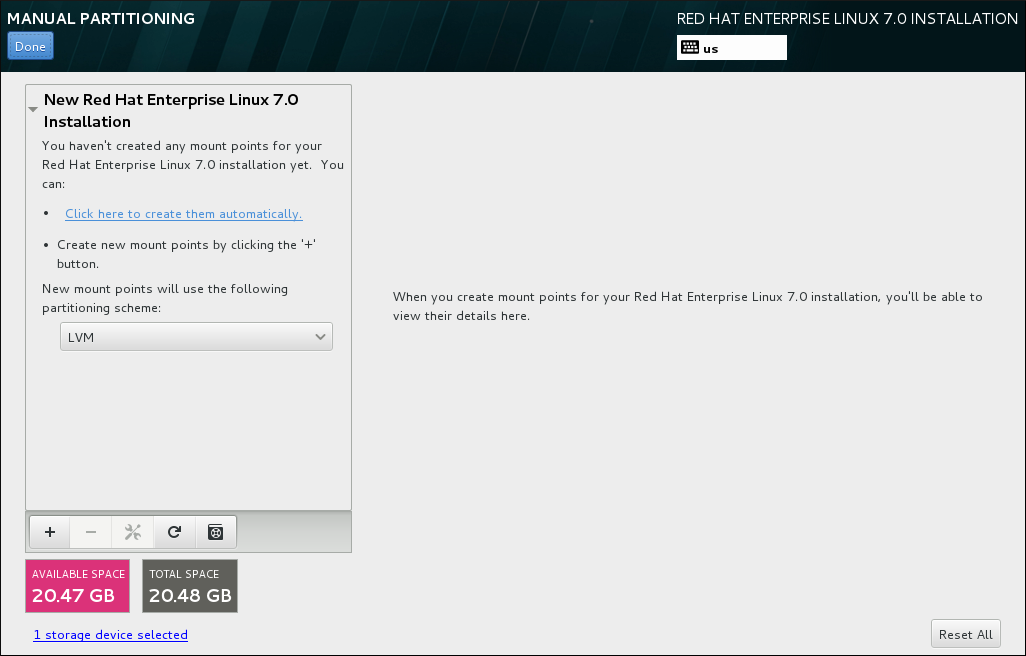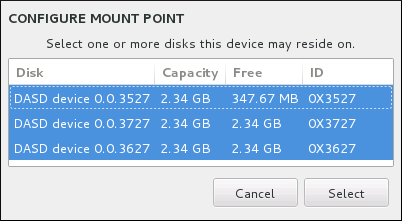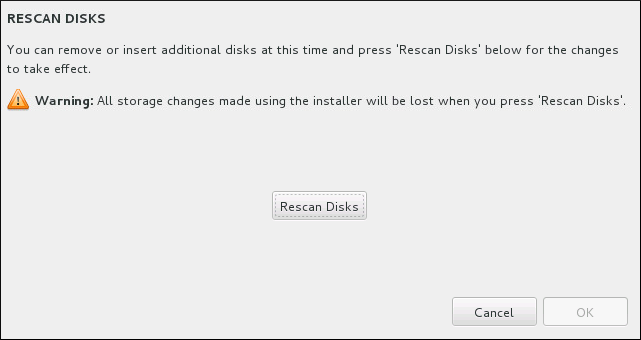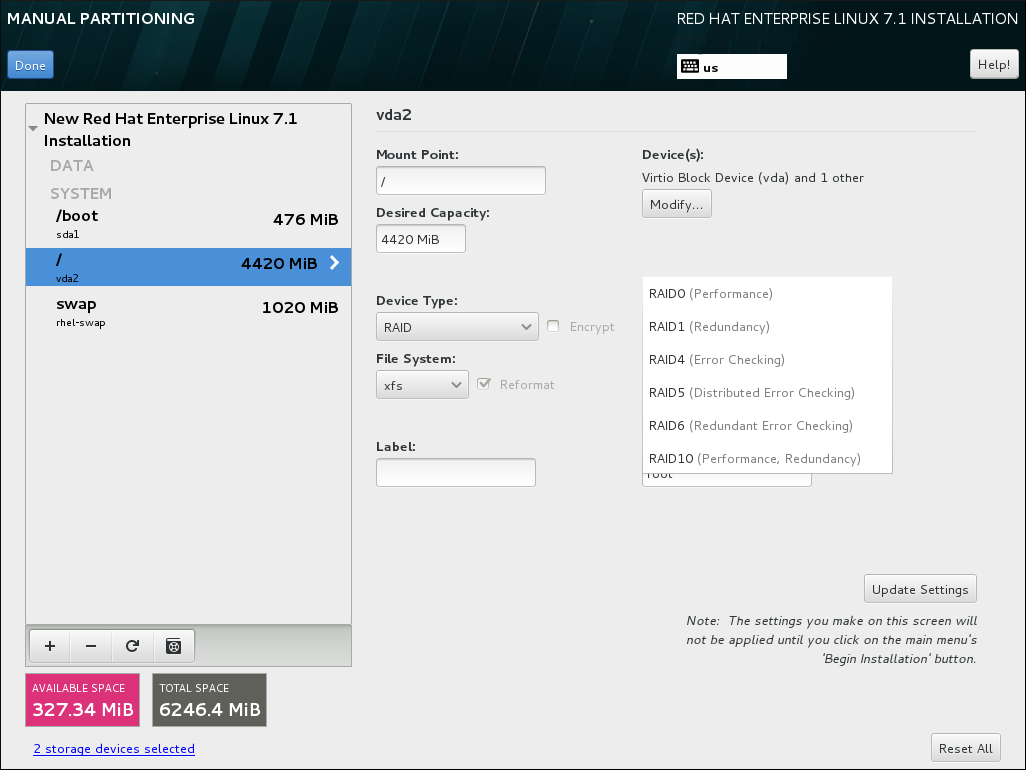18.15. Installation Destination
Warning
Important
Figure 18.14. Storage Space Overview
Warning
/etc/dasd.conf configuration file as described in Section 20.1.3, “Persistently Setting DASDs Online”.
- In the Partitioning section, you can select how storage devices are partitioned and how volumes are created. You can configure the partitions, manually or allow the installation program to do it automatically.Automatic partitioning is recommended if you are doing a clean installation on previously unused storage or do not need to keep any data that might be present on the storage. To proceed this way, leave the default selection of the Automatically configure partitioning radio button, and the installation program will create the necessary partitions and volumes on the storage space for you.For automatic partitioning, you can also select the I would like to make additional space available check box to choose how to reassign space from other file systems to this installation. After you click , there are two dialogs that can appear. If you selected automatic partitioning but there is not enough storage space to complete the installation using the recommended partitioning configuration, a dialog will appear:
Figure 18.15. Installation Options Dialog with Option to Reclaim Space
You can click to the Red Hat Enterprise Linux software selection link. The link will navigate you to the Software selection section, where you can change what software you want to install, and free some aditional storage space.Alternatively, you can click to return to the Installation Destination screen, where it is possible to add more storage devices, or to choose to configure partitioning manually. Click to free some storage space from existing file systems. See Section 18.15.2, “Reclaim Disk Space” for details.The second dialog appears if you cannot create enough free space. In this case, you have to add more disks on the initial storage screen or quit the installation.If you select the I will configure partitioning radio button for manual setup, you will be brought to the Manual Partitioning screen after clicking . See Section 18.15.3, “Manual Partitioning” for details. - In the Encryption section, you can select the Encrypt my data check box to encrypt all partitions except for the
/bootpartition. See the Red Hat Enterprise Linux 7 Security Guide for information on encryption.
Important
18.15.1. Encrypt Partitions
Figure 18.16. Enter Passphrase for an Encrypted Partition
Warning
18.15.2. Reclaim Disk Space
Warning
Figure 18.17. Reclaim Disk Space from Existing File Systems
- - leaves the file system untouched and no data will be deleted. This is the default action.
- - removes the file system entirely. All the space it takes up on the disk will be made available for the installation.
- - recovers free space from the file system and makes it available for this installation. Use the slider to set a new size for the selected partition. Can only be used on resizable partitions where LVM or RAID is not used.
- - this button, located on the right, marks all file systems for deletion by default. Upon clicking, it changes the label and allows you to mark all file systems to be preserved again.
18.15.3. Manual Partitioning
Warning
Figure 18.18. The Manual Partitioning Screen
Note
/boot. The kernel files and boot loader sector will be associated with this device. The first DASD or SCSI LUN will be used, and the device number will be used when re-IPLing the post-installed system.
18.15.3.1. Adding File Systems and Configuring Partitions
/, /home, /boot, and swap. You can also create additional partitions and volumes as you require. See Section 18.15.3.4, “Recommended Partitioning Scheme” for further details.
Note
/boot partition, a / (root) volume, and a swap volume proportionate to the size of the available storage. These are the recommended file systems for a typical installation, but you can add additional file systems and mount points if you need to.
/ for the root partition or /boot for the boot partition. Then enter the size of the file system in the Desired Capacity text field; for example, 2GiB. If you leave the field empty or if you specify a size bigger than available space, all remaining free space is used instead. After entering these details, click the button to create the partition.
Note
/boot, and then create the rest of the partitions, letting the installation program allocate the remaining capacity to them.
Standard Partition, BTRFS, LVM, and LVM Thin Provisioning. Note that the /boot partition will always be located on a standard partition, regardless of the value selected in this menu.
Figure 18.19. Configuring Mount Points
Figure 18.20. Rescanning Disks
Figure 18.21. Customizing Partitions
- Mount Point - enter the file system's mount point. For example, if a file system should be the root file system, enter
/; enter/bootfor the/bootfile system, and so on. For a swap file system, the mount point should not be set - setting the file system type toswapis sufficient. - Desired Capacity - enter the desired size of the file system. You can use common size units such as KiB or GiB. The default is MiB if no other unit is specified.
- Device type - choose one of these types: Standard Partition, LVM, RAID, LVM Thin Provisioning, or BTRFS. Check the adjacent Encrypt box to encrypt the partition or volume. You will be prompted to set a password later. RAID is only available if two or more disks are selected for partitioning, and if you choose this type, you can also set the RAID Level. Similarly, if you select LVM, you can specify the Volume Group.
- File system - in the drop-down menu, select the appropriate file system type for this partition or volume. Check the adjacent Reformat box to format an existing partition, or leave it unchecked to retain your data. Note that newly created partitions and volumes must be reformatted, and the check box cannot be unchecked in this case.
- Label - assign a label to the partition. Labels are used for you to easily recognize and address individual partitions.
- Name - assign a name to an LVM or Btrfs volume. Note that standard partitions are named automatically when they are created and their name cannot be edited, such as
/homebeing assigned the namesda1.
Important
/usr or /var is partitioned separately from the rest of the root volume, the boot process becomes much more complex because these directories contain components critical to it. In some situations, such as when these directories are placed on an iSCSI drive or an FCoE location, the system can either be unable to boot, or hang with a Device is busy error when powering off or rebooting.
/usr or /var, not to directories below them. For example, a separate partition for /var/www will work without issues.
18.15.3.1.1. File System Types
Device Types
- standard partition - A standard partition can contain a file system or swap space, or it can provide a container for software RAID or an LVM physical volume.
- logical volume (LVM) - Creating an LVM partition automatically generates an LVM logical volume. LVM can improve performance when using physical disks. For information on how to create a logical volume, see Section 18.15.3.3, “Create LVM Logical Volume”. For more information regarding LVM, see the Red Hat Enterprise Linux 7 Logical Volume Manager Administration guide.
- LVM thin provisioning - Using thin provisioning, you can manage a storage pool of free space, known as a thin pool, which can be allocated to an arbitrary number of devices when needed by applications. The thin pool can be expanded dynamically when needed for cost-effective allocation of storage space. For more information regarding LVM, see the Red Hat Enterprise Linux 7 Logical Volume Manager Administration guide.
Note
The installer will automatically reserve 20% of any requested space for an LVM thin pool logical volume in the volume group containing it. This is a safety measure to ensure that you can extend either the metadata volume or the data volume of your thinly provisioned logical volume. - software RAID - Creating two or more software RAID partitions allows you to create a RAID device. One RAID partition is assigned to each disk on the system. To create a RAID device, see Section 18.15.3.2, “Create Software RAID”. For more information regarding RAID, see the Red Hat Enterprise Linux 7 Storage Administration Guide.
File Systems
- xfs - XFS is a highly scalable, high-performance file system that supports file systems up to 16 EiB (approximately 16 billion GiB), files up to 8 EiB (approximately 8 billion GiB), and directory structures containing tens of millions of entries. XFS supports metadata journaling, which facilitates quicker crash recovery. The XFS file system can also be defragmented and resized while mounted and active. This file system is selected by default and is highly recommended. For information on how to translate common commands from previously used ext4 file system to XFS, see Appendix F, Reference Table for ext4 and XFS Commands.The maximum supported size of an XFS file system in Red Hat Enterprise Linux is currently 500 TiB.
- ext4 - The ext4 file system is based on the ext3 file system and features a number of improvements. These include support for larger file systems and larger files, faster and more efficient allocation of disk space, no limit on the number of subdirectories within a directory, faster file system checking, and more robust journaling.The maximum supported size of an ext4 file system in Red Hat Enterprise Linux is currently 50 TiB.
- ext3 - The ext3 file system is based on the ext2 file system and has one main advantage - journaling. Using a journaling file system reduces time spent recovering a file system after a crash as there is no need to check the file system for metadata consistency by running the
fsckutility every time a crash occurs. - ext2 - An ext2 file system supports standard Unix file types, including regular files, directories, or symbolic links. It provides the ability to assign long file names, up to 255 characters.
- vfat - The VFAT file system is a Linux file system that is compatible with Microsoft Windows long file names on the FAT file system.
- swap - Swap partitions are used to support virtual memory. In other words, data is written to a swap partition when there is not enough RAM to store the data your system is processing.
18.15.3.2. Create Software RAID
Note
Figure 18.22. Creating a Software RAID Partition - the Device Type Menu Expanded
- Create a mount point as described in Section 18.15.3.1, “Adding File Systems and Configuring Partitions”. By configuring this mount point, you configure the RAID device.
- Keeping the partition selected in the left pane, select the configuration button below the pane to open the Configure Mount Point dialog. Select which disks will be included in the RAID device and click .
- Click the Device Type drop-down menu and select RAID.
- Click the File System drop-down menu and select your preferred file system type (see Section 8.14.4.1.1, “File System Types”.
- Click the RAID Level drop-down menu and select your preferred level of RAID.The available RAID levels are:
- RAID0 - Optimized performance (stripe)
- Distributes data across multiple disks. Level 0 RAIDs offer increased performance over standard partitions, and can be used to pool the storage of multiple disks into one large virtual device. Note that Level 0 RAIDs offer no redundancy, and that the failure of one device in the array destroys data in the entire array. RAID 0 requires at least two RAID partitions.
- RAID1 - Redundancy (mirror)
- Mirrors all data on one disk onto one or more other disks. Additional devices in the array provide increasing levels of redundancy. RAID 1 requires at least two RAID partitions.
- RAID4 - Error detection (parity)
- Distributes data across multiple disks, and uses one disk in the array to store parity information that safeguards the array in case any disk within the array fails. Because all parity information is stored on one disk, access to this disk creates a bottleneck in the performance of the array. RAID 4 requires at least three RAID partitions.
- RAID5 - Distributed error detection
- Distributes data and parity information across multiple disks. Level 5 RAIDs therefore offer the performance advantages of distributing data across multiple disks, but do not share the performance bottleneck of level 4 RAIDs because the parity information is also distributed through the array. RAID 5 requires at least three RAID partitions.
- RAID6 - Redundant
- Level 6 RAIDs are similar to level 5 RAIDs, but instead of storing only one set of parity data, they store two sets. RAID 6 requires at least four RAID partitions.
- RAID10 - Redundancy (mirror) and Optimized performance (stripe)
- Level 10 RAIDs are nested RAIDs or hybrid RAIDs. They are constructed by distributing data over mirrored sets of disks. For example, a level 10 RAID array constructed from four RAID partitions consists of two mirrored pairs of striped partitions. RAID 10 requires at least four RAID partitions.
- Click to save your changes, and either continue with another partition or click to return to the Installation Summary screen.
18.15.3.3. Create LVM Logical Volume
Important
lvm command. To return to the text-mode installation, press Ctrl+Alt+F1.
Figure 18.23. Configuring a Logical Volume
- Create a mount point for the LVM volume as described in Section 18.15.3.1, “Adding File Systems and Configuring Partitions”.
- Click the Device Type drop-down menu and select LVM. The Volume Group drop-down menu appears and displays the newly-created volume group name.
- Optionally, either click the menu and select Create a new volume group or click to configure the newly-created volume group, if you need to. Both the Create a new volume group option and the button lead to the Configure Volume Group dialog, where you can rename the logical volume group and select which disks will be included.
Note
The configuration dialog does not allow you to specify the size of the volume group's physical extents. The size will always be set to the default value of 4 MiB. If you want to create a volume group with different physical extents, create it manually by switching to an interactive shell and using thevgcreatecommand, or use a Kickstart file with thevolgroup --pesize=sizecommand.Figure 18.24. Customizing an LVM Volume Group
The available RAID levels are the same as with actual RAID devices. See Section 18.15.3.2, “Create Software RAID” for more information. You can also mark the volume group for encryption and set the size policy for it. The available policy options are:- Automatic - the size of the volume group is set automatically so that it is just large enough to contain the configured logical volumes. This is optimal if you do not need free space within the volume group.
- As large as possible - the volume group is created with maximum size, regardless of the size of the configured logical volumes it contains. This is optimal if you plan to keep most of your data on LVM and later need to increase the size of some existing logical volumes, or if you need to create additional logical volumes within this group.
- Fixed - with this option, you can set an exact size of the volume group. Any configured logical volumes must then fit within this fixed size. This is useful if you know exactly how large you would like the volume group to be.
Click when the group is configured. - Click to save your changes, and either continue with another partition or click to return to the Installation Summary screen.
Warning
/boot partition on an LVM volume is not supported.
18.15.3.4. Recommended Partitioning Scheme
- 'Chapter 7. Linux Swapping' in the IBM Redbooks publication Linux on IBM System z: Performance Measurement and Tuning [IBM Form Number SG24-6926-01], [ISBN 0738485586], available from http://www.redbooks.ibm.com/abstracts/sg246926.html
- Linux Performance when running under VM, available from http://www.vm.ibm.com/perf/tips/linuxper.html


